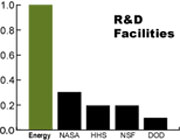 |
|
On Time, On Budget
By Ron Lutha and Dan Lehman, Department of Energy
In recent years, however, the Departmentís record on building such projects within the time and budget allotments prescribed by Congress has been less than perfect. The example of the Superconducting Super Collider, a project whose initial price tag of $5.9 billion rose to $10.5 billion before Congress pulled the plug, will not soon fade from physicistsíñor Congressísñmemories. So it is particularly important for the Department of Energy and its national laboratories to demonstrate that they can reliably build large scientific facilities on time and on budget. We have all had that reality in mind as we built the Main Injector. Keeping a project on schedule and within budget is neither rocket science nor black magic. It does require a good project management team, good designs, good market conditions, good labor relations, low inflation rates, the ability to control changes, and the appropriate use of management tools. Obviously we have more control over some of those factors than we do over others. We canít do much about the price of copper or the rate of inflation. But by far the most critical factors, in our experience, are good rapport and cohesive teamwork among all the individuals and organizations involved in the project. Much of the success in keeping the Fermilab Main Injector Project on schedule and within budget has come from the working relationship between the Fermilab Main Injector organization and the Department of Energy. This relationship has allowed both organizations to carry out their project obligations cost-effectively and efficiently. Together, they made a team that was determined to adhere to their schedule and budget commitments. The Main Injector Projectís baselines for scope; cost and schedule; and management plan were presented by the DOE project manager to the Energy Systems Acquisitions Advisory Board and approved by Secretary of Energy James Watkins on June 16, 1992. The projectís budget and schedule baselines stipulated that the project be completed by the third quarter of FY1999 within a cost estimate of $259 million. These baselines constitute the projectís commitment to Congress. The project has achieved them. Throughout the life of the Main Injector, the Department of Energyís High Energy Physics program office has tracked these commitments by means of reviews, held every six months. The onsite DOE project manager has also met weekly with the Laboratory project managers. The Main Injector Project teamís commitment to the baseline, their ability to make timely decisions and their willingness to take corrective actions when they were called for kept the project within budget and on schedule. The Main Injector Project carried on Fermilabís tradition of building only what was necessary and avoiding "gold-plated" designs. Although the original design appeared realistic, design changes are almost always required to resolve unforeseen problems, and the Main Injector was no exception. But proposed design changesñ"engineering change requests"ñ were approved only after careful consideration by the project management team and the DOE review committee. The use of permanent magnets to focus and bend the beam for the 8 GeV beam transfer line, instead of the originally proposed electromagnets, is a good example. Making this change allowed the project to capture savings in maintenance costs, energy consumption, and water use by adopting a new concept in accelerator design. And when unexpected problems arose, such as the infamous microbiological induced corrosion (also known as "bugs in the water pipes"), the project team met the challenge head on to overcome the problem. Experience counts. The success in building the conventional facilities (thatís project-speak for concrete tunnels and buildings) owed much to the Main Injector Project teamís experience, backed up by the strong support of the Facilities Engineering Services Section, in working with Fluor Daniel, the architectural engineering firm, and the many construction subcontractors. These teams have built things before. Although most of the Main Injector construction took place on a "green," or previously unused, site, several pieces of the project were especially challenging because they interlaced with existing accelerator facilities. Keeping them on track required tight shutdown schedules and careful coordination with the rest of the Laboratory. While there were clearly many factors at work to keep the Main Injector Project on track, we continue to believe that the truly indispensable elements were the quality of the project team and the good working relationship between the project management and the Department of Energy. With those pieces in place, the Main Injector Project has carried on the Fermilab tradition of building great particle accelerators within budget and on schedule. The results will benefit not only Fermilab and its users but the entire Department of Energy science mission, now and in the years to come.
|
| last modified 6/1/1999 email Fermilab |
FRLsDFx9eyfrPXgV
 The Department
of Energy has a long and proud history of building and operating large-scale scientific
user facilities. Of the five agencies that fund most federally sponsored scientific
research in the U.S., DOE is by far the largest supporter of research and development
facilities. The national laboratories, including Fermilab, are living proof of DOEís
long-term investment in the megatools of science.
The Department
of Energy has a long and proud history of building and operating large-scale scientific
user facilities. Of the five agencies that fund most federally sponsored scientific
research in the U.S., DOE is by far the largest supporter of research and development
facilities. The national laboratories, including Fermilab, are living proof of DOEís
long-term investment in the megatools of science.